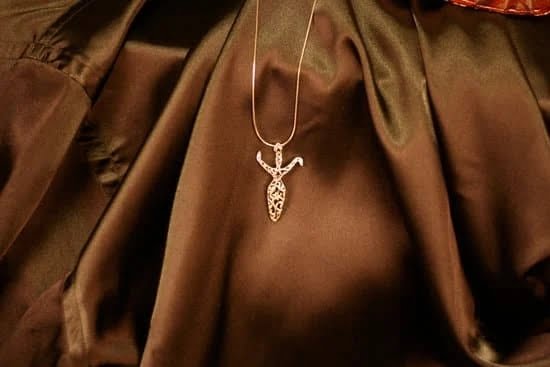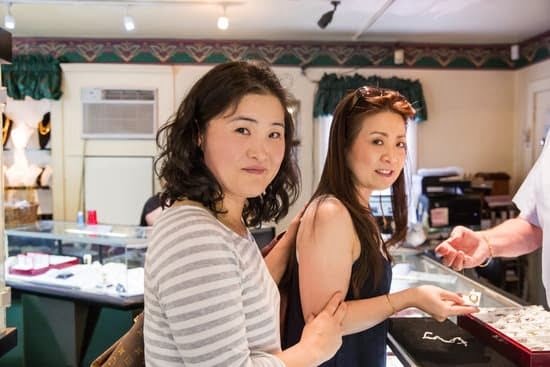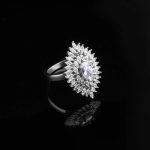The history of the jewelry industry is a captivating tale that spans centuries, filled with shimmering gemstones, intricate designs, and the undeniable allure of personal adornment. From ancient civilizations to modern luxury brands, jewelry has always held a special place in society, symbolizing wealth, status, love, and personal expression. In this article, we will embark on a journey through time, exploring the glittering pathways of the jewelry industry and uncovering the stories behind its evolution.
To truly understand the significance of jewelry throughout history, it is important to acknowledge its enduring allure. Jewelry has been cherished for centuries by individuals from all walks of life for its ability to captivate the eye and evoke emotion. From simple ornaments crafted by primitive societies to exquisite pieces worn by royalty, each piece tells a unique story and embodies cultural traditions and artistic expressions.
Our exploration begins by unearthing the first glimmers of jewelry in ancient civilizations. We will delve into the earliest known examples of adornment, from primitive ornaments to the dazzling treasures of ancient Egyptian pharaohs and Mesopotamian kings. By examining these artifacts and understanding their materials, techniques, and cultural significance, we can appreciate how jewelry has transcended time and culture.
As we journey through history, we will also explore pivotal moments that shaped the course of the jewelry industry. The Renaissance witnessed a revival in craftsmanship and saw a transition from religious to personal adornment. Prominent workshops in Italy played a crucial role in advancing design and craftsmanship during this period. We will also examine how royal patronage influenced jewelry trends and innovations throughout history.
From there, we will witness how technological advancements during the Industrial Revolution transformed jewelry production on an unprecedented scale. Handcrafted pieces gave way to mass production in bustling factories, making jewelry more accessible than ever before. This shift had profound implications for not just aesthetics but also affordability.
Throughout our exploration of this rich tapestry that is the history of the jewelry industry, we will also delve into aesthetic movements such as Art Nouveau and Art Deco that inspired jewelry design, materials, and motifs. We will examine their impact on the industry and showcase designers who played pivotal roles during these eras.
Finally, we will bring our journey to the present day, examining the changing face of the jewelry industry in the mid-20th century and beyond. We will analyze how societal, cultural, and economic changes have influenced trends in jewelry, as well as the rise of luxury brands and an increasing focus on ethical practices.
Join us as we embark on this glittering exploration through time. By understanding the history of the jewelry industry, we can gain insights into its remarkable journey and appreciate its enduring allure. So prepare to be dazzled by a world of precious gemstones, intricate designs, and centuries-old traditions as we unravel the captivating story behind one of humanity’s most enchanting art forms.
Ancient Origins
In the section of “Ancient Origins: Unearthing the First Glimmers of Jewelry,” we delve into the earliest known examples of jewelry and explore their cultural significance and craftsmanship. The history of jewelry dates back thousands of years, with primitive ornaments being one of the first forms of personal adornment. These early pieces were made from various materials such as shells, animal bones, feathers, and stones.
One of the most notable civilizations in terms of jewelry production is ancient Egypt. Egyptians used a wide range of materials including gold, silver, precious gems like emerald and lapis lazuli, and even glass to create intricate adornments. Their jewelry was not only worn for aesthetics but also held religious and symbolic value. Amulets, for example, were believed to bring protection or luck to the wearer.
The Mesopotamian civilization also played a significant role in shaping the history of jewelry. They developed advanced metalworking techniques which allowed them to create elaborate pieces using gold, silver, and gemstones. In addition to decorative purposes, their jewelry served as status symbols and amulets as well. Similarly, ancient Indus Valley civilizations showcased remarkable craftsmanship by incorporating intricate filigree work and enameling on their jewelry.
These ancient civilizations laid the foundation for the rich tapestry that is today’s jewelry industry. Through their materials, techniques, and cultural significance behind these ancient treasures, we can trace how jewelry evolved over time to become an integral part of human expression and identity.
Renaissance and The Birth of Modern Jewelry
During the Renaissance, the jewelry industry experienced a significant revival and underwent a transformative shift, leading to the birth of modern jewelry. This period marked a transition from the primarily religious use of jewelry to more personal adornment. As society evolved and became more interested in self-expression and individual style, jewelers began to embrace new designs, techniques, and materials.
Italy played a crucial role in driving this newfound interest in jewelry during the Renaissance. Cities like Florence and Venice were home to prominent workshops and skilled artisans who produced exquisite pieces for both Italian and international clientele. Italian jewelers pioneered innovative techniques such as gemstone engraving, filigree work, and the use of gem settings such as pavé or collet settings.
One notable figure during this era was Benvenuto Cellini, an Italian goldsmith considered one of the greatest craftsmen of his time. His craftsmanship extended beyond traditional jewelry-making; he also created elaborate decorative objects like ewers, cups, and salt cellars for royal patrons. Cellini’s autobiography further popularized his reputation as a talented artist, contributing to the growing appreciation for jewelry as both an art form and symbol of status.
The evolution of design and craftsmanship during the Renaissance led to a greater emphasis on symmetry, proportionality, and naturalistic motifs inspired by Greco-Roman art. Jewelry became more elaborate with intricate detailing and vibrant gemstones. Pearls were highly prized during this period, often used in necklaces or earrings worn by men and women alike.
Overall, the Renaissance was a pivotal period that propelled the jewelry industry forward towards modernity. The shift from religious to personal adornment allowed for greater creativity and experimentation in design. The influence of prominent Italian workshops continues to be felt in contemporary jewelry-making, making this era an essential part of the rich tapestry that is the history of the jewelry industry.
Royal Splendor
The royal splendor associated with jewelry has played a significant role in shaping the course of the industry throughout history. Monarchs and aristocracy have not only been patrons of the art form, but they have also influenced innovations and set trends that continue to resonate today.
One notable example of how monarchs shaped the course of jewelry is through their opulent collections and iconic pieces. Royal families around the world have amassed treasures that are renowned for their beauty and historical importance. For instance, the Crown Jewels of the United Kingdom includes some of the most well-known royal jewelry, such as the Koh-i-Noor diamond and the Imperial State Crown. These pieces not only symbolize regal power but also showcase exceptional craftsmanship and design.
Monarchs and aristocrats also influenced trends in jewelry by setting examples through their personal style choices. When a queen or princess wore a particular type of jewelry or embraced a specific design, it often became fashionable among the nobility and affluent classes. This trendsetting influence can be seen throughout history, from Queen Victoria popularizing mourning jewelry during her reign to Princess Diana sparking a trend for sapphire engagement rings.
Monarchs also played a vital role in commissioning exquisite pieces from renowned jewelers, thereby nurturing talent and pushing boundaries in craftsmanship and design. Famous jewelers like Cartier owe much of their success to royal patrons who sought unique creations to reflect their status. The close relationship between monarchy and jewelry continues even today, as many contemporary luxury brands collaborate with royal families or draw inspiration from historical royal collections.
DATA
| Monarch | Notable Piece | Description |
|---|---|---|
| Queen Elizabeth II | The Coronation Necklace | A necklace composed of diamonds and pearls gifted to Queen Elizabeth II for her coronation in 1953 |
| Marie Antoinette | The Marie Antoinette Necklace | A diamond necklace made for the iconic French queen, featuring more than 300 diamonds and pearls |
| Catherine the Great | The Catherine the Great Sapphire Bracelet | A bracelet adorned with sapphires and diamonds, gifted to Catherine the Great by Napoleon Bonaparte |
Royal splendor, throughout history, has not only influenced jewelry trends but has also served as a source of inspiration for jewelers and designers. The grandeur associated with monarchs’ personal collections and their significant role in driving innovation continue to captivate the imagination and fuel creativity within the jewelry industry.
The allure of royal jewelry extends beyond its aesthetic appeal. These pieces often hold historical and cultural significance, representing grand occasions, powerful dynasties, or symbolic meanings embedded within different cultures. The craftsmanship involved in creating jewelry fit for royalty is unparalleled, with intricate details and impeccable execution elevating these pieces to masterpieces of art.
As we reflect on how monarchs shaped the course of jewelry, it is evident that their influence extends far beyond individual adornment. They acted as patrons who propelled the industry forward through their support of talented artisans and their promotion of exquisite creations. Their legacy can be seen in the continued fascination with royal jewelry and in the timeless designs that continue to inspire contemporary jewelers worldwide.
The Industrial Revolution
During the Industrial Revolution, technological advancements revolutionized the production of jewelry, marking a significant shift from traditional craftsmanship to mass production. This transformation had profound implications for accessibility and affordability, making jewelry more attainable for a wider range of individuals.
One of the key impacts of the Industrial Revolution on the jewelry industry was the development of new machinery and techniques that enabled mass production. Prior to this period, jewelry was primarily made by hand, often by skilled artisans who spent hours crafting intricate designs. However, with the advent of machines such as steam-powered rolling mills and precision cutting tools, jewelry factories were able to produce pieces at a much faster rate.
The introduction of mass production also led to a greater availability and variety of jewelry styles. With increased efficiency in manufacturing processes, jewelers were able to create more affordable pieces using less expensive materials. This allowed individuals from different social classes to own and wear jewelry, which had previously been reserved for the upper echelons of society. Additionally, a wider range of designs became accessible to consumers as jewelers were able to replicate popular styles more easily.
Overall, the Industrial Revolution brought about a significant transformation in the way jewelry was produced. The shift from handcrafted to mass-produced pieces not only made jewelry more accessible and affordable but also contributed to the diversification of styles available in the market. These changes laid the foundation for future innovations in the industry and set the stage for further advancements in design and technology.
Art Nouveau and Art Deco
Art Nouveau: A Celebration of Nature and Whimsicality
The Art Nouveau movement, which emerged in the late 19th century and flourished until the early 20th century, had a profound influence on the world of jewelry. Inspired by natural forms and organic structures, Art Nouveau jewelry captured the essence of nature with its fluid lines, intricate details, and romantic motifs.
- Characteristics of Art Nouveau Jewelry Art Nouveau jewelry was characterized by its emphasis on curved lines, asymmetrical shapes, and sensuous curves. This departure from the rigid symmetry and structured designs of previous eras marked a new era for jewelry design. Artists drew inspiration from plants, flowers, insects, and mythical creatures to create expressive pieces that seemed to come alive.
- Prominent Art Nouveau Designers René Lalique is often hailed as one of the leading figures in Art Nouveau jewelry design. His innovative use of materials such as glass and enamel revolutionized the industry. Lalique’s intricate designs featuring dragonflies, orchids, and femme fatales encapsulated the elegance and enchantment of Art Nouveau.
- 3. Legacy of Art Nouveau Jewelry Although the popularity of the Art Nouveau movement waned after World War I with the rise of Art Deco aesthetics, its influence can still be seen today. The fluid lines and nature-inspired motifs continue to inspire contemporary jewelry designers who seek to capture the essence of beauty found in everyday surroundings.
Other notable Art Nouveau designers include Georges Fouquet, whose creations showcased an exquisite combination of gemstones and enameling techniques; Louis Comfort Tiffany, renowned for his stunning stained glass works that translated seamlessly into his jewelry designs; and Carlo Giuliano, known for his incorporation of vibrant colors in his intricate pieces.
Art Deco: A Union of Modernism and Glamour
Following the First World War, a shift occurred in art movements that reflected society’s desire for a fresh start and a departure from the past. The Art Deco movement emerged, characterized by its modernistic designs, geometric shapes, and luxurious materials. This shift had a significant impact on the world of jewelry, redefining the industry with its boldness and glamour.
- Characteristics of Art Deco Jewelry Art Deco jewelry embraced symmetry, clean lines, and intricate patterns to create visually striking pieces that exuded luxury. Geometric forms such as triangles, squares, and rectangles prevailed in designs influenced by ancient Egypt and other non-Western civilizations. Diamonds were also favored during this era due to advances in diamond cutting techniques that allowed for enhanced brilliance.
- Prominent Art Deco Designers Cartier played a pivotal role in defining the aesthetics of Art Deco jewelry. Their innovative designs incorporated both precious gemstones and semi-precious stones, embedding them in platinum settings to maximize their radiance and elegance. Other notable designers who made their mark during this era include Van Cleef & Arpels, Coco Chanel, and Suzanne Belperron.
- Legacy of Art Deco Jewelry The enduring legacy of Art Deco jewelry can be seen in contemporary design trends that draw inspiration from its geometric forms and lavishness. Its influence extended beyond jewelry to architecture, fashion, and interior design, leaving an indelible mark on the overall aesthetic landscape of the time.
Mid-20th Century to Present
Societal, Cultural, and Economic Changes
The mid-20th century witnessed significant societal, cultural, and economic changes that had a profound impact on the jewelry industry. The end of World War II brought about a shift in social attitudes and values, as well as an increase in disposable income. This newfound prosperity led to a growing demand for luxury goods, including jewelry.
One notable change during this period was the rise of women’s empowerment and their increasing participation in the workforce. Women were gaining more independence and purchasing power, which fueled the demand for jewelry that reflected their evolving roles and aspirations. Jewelry designers responded by creating pieces that were versatile, sophisticated, and embraced modern aesthetics.
Additionally, the cultural shifts of the 1960s and 1970s ushered in new trends in jewelry design. The counterculture movement challenged traditional notions of beauty, prompting jewelers to experiment with unconventional materials and styles. The use of natural materials like wood and bone became more prevalent, reflecting a desire for authenticity and connection with nature.
New Materials and Styles
The mid-20th century also witnessed breakthroughs in material technology that revolutionized the jewelry industry. In the 1950s, scientists developed synthetic gemstones such as cubic zirconia and created methods to produce colored diamonds artificially. These advancements made gemstones more affordable and accessible to a wider audience.
Furthermore, during this period, many jewelers embraced innovative styles inspired by contemporary art movements such as Pop Art and Minimalism. Bold geometric shapes, vibrant colors, and unconventional designs became increasingly popular. Jewelry started to become an expressive form of personal identity rather than solely a symbol of status or wealth.
Ethical Practices and Sustainability
As awareness grew about environmental issues and human rights abuses associated with mining gemstones or producing precious metals, ethical practices began to play a significant role in shaping the industry. Consumers became more conscious of the impact their purchases had on the planet and individuals involved in the supply chain.
Jewelry companies responded by adopting ethical sourcing practices, ensuring they used conflict-free diamonds and fair-trade gemstones. Moreover, sustainability became a key concern, with designers integrating recycled materials into their creations and embracing environmentally friendly manufacturing processes.
The changing face of the jewelry industry during this period reflected not only shifts in society and culture but also a growing emphasis on responsibility and environmental stewardship. Jewelers of the mid-20th century onwards recognized the importance of not only creating beautiful pieces but also producing them responsibly, reflecting the evolving values of both consumers and society as a whole.
The Future of the Jewelry Industry
The jewelry industry is constantly evolving, influenced by societal changes, technological advancements, and shifting consumer preferences. As we look to the future, it is fascinating to speculate on the upcoming trends and innovations that will shape the industry. In this section, we will explore some of these developments and discuss their potential impact on the jewelry market.
One major trend that is already transforming the jewelry industry is the rise of sustainable and ethical practices. Consumers are becoming increasingly conscious of the environmental and social impact of their purchases, and this awareness is reflected in their demand for ethically sourced gemstones, recycled metals, and responsibly made jewelry. In response to this shift, many jewelry brands are adopting sustainable practices throughout their supply chains, ensuring transparency in sourcing materials and supporting fair trade initiatives.
This movement towards sustainability is not only driven by consumer demand but also by regulatory changes and a growing concern for the environment. As we move forward, it is expected that sustainability will become a defining factor in shaping the future of the jewelry industry.
Another significant development in the future of the jewelry industry is the role of technology in customization. With advancements in 3D printing technology, augmented reality, and artificial intelligence, consumers now have more options than ever before to create personalized pieces of jewelry. This trend towards customization extends beyond unique designs and includes personalized engraving or even custom-made gemstones tailored to individual preferences.
Technology has also revolutionized how consumers shop for jewelry with e-commerce platforms offering virtual try-on features and online marketplaces providing a wider range of choices. Social media platforms have also become powerful tools for jewelers to showcase their products and build brand awareness among target audiences.
| Trends | Innovations |
|---|---|
| Rise of sustainable/ethical practices | Advancements in 3D printing technology, augmented reality, and artificial intelligence |
| Increasing demand for ethically sourced gemstones and responsibly made jewelry | E-commerce platforms with virtual try-on features and online marketplaces providing wider choices |
| Focus on transparency in sourcing materials and supporting fair trade initiatives | Social media platforms as powerful tools for showcasing products and building brand awareness |
As we move into the future, it is clear that the jewelry industry will continue to evolve and adapt to changing consumer needs and preferences. Sustainability, customization, and technology are only a few of the many trends and innovations shaping the industry.
The key for jewelers will be to stay ahead of these changes, embrace new technologies, adopt responsible practices, and continue to create beautiful pieces of jewelry that captivate and inspire. By doing so, they can ensure their place in this glittering world that has fascinated humanity for centuries.
Conclusion
The jewelry industry is a true testament to the enduring allure of craftsmanship and creativity. Throughout history, it has evolved and transformed, adapting to societal changes and technological advancements. From ancient origins to the modern era, the jewelry industry has left an indelible mark on human culture.
Looking back at the rich tapestry of the jewelry industry, it becomes apparent that this art form has always held immense significance. From primitive ornaments to opulent royal collections, jewelry has been a symbol of wealth, power, and personal expression. It has adorned the necks, wrists, and fingers of individuals throughout time and across cultures.
As we reflect on the journey of the jewelry industry, we can appreciate how it has been shaped by key milestones and transformations. The Renaissance sparked a revival in craftsmanship and design, breaking away from religious symbolism to embrace personal adornment. The Industrial Revolution brought about mass production and accessibility, allowing more people to enjoy the beauty of fine jewelry. The Art Nouveau and Art Deco movements inspired innovative design concepts that continue to influence modern creations.
In today’s world, the jewelry industry continues to evolve with changing trends and consumer demands. Luxury brands reign supreme while ethical practices gain importance in an increasingly conscious society. Technology has enabled customization and personalized experiences for consumers, making jewelry more accessible than ever before.
As we conclude our exploration of the history of the jewelry industry, let us remember that behind each precious gemstone or carefully crafted piece lies a story waiting to be told. Jewelry is not just an accessory; it is a reflection of human creativity, culture, and individuality. So let us cherish this remarkable art form that has captivated hearts for centuries and continue to celebrate its enduring allure for years to come.

Welcome to my jewelry blog! My name is Sarah and I am the owner of this blog.
I love making jewelry and sharing my creations with others.
So whether you’re someone who loves wearing jewelry yourself or simply enjoys learning about it, be sure to check out my blog for insightful posts on everything related to this exciting topic!





